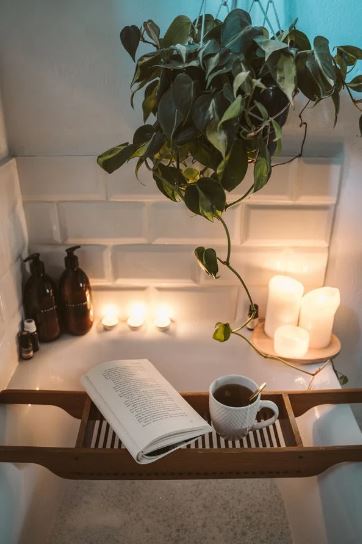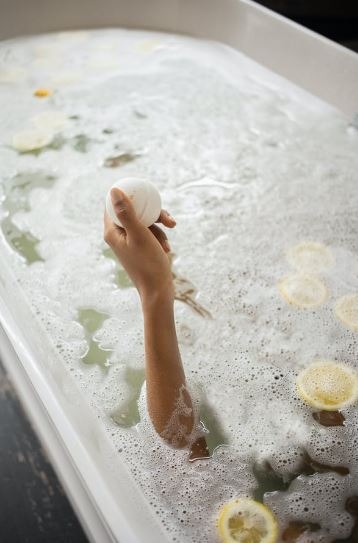Bathing has had quite a trip over the past several millennia, evolving from a public social activity in Ancient Rome to something we do in the privacy of our own homes, first for cleaning and sanitation, and then as a way to unwind.
In recent years, however, bathtubs have made a remarkable comeback, due in part to their marketing as a simple, yet luxurious act of self-care. Moreover, unlike many of the other suggested methods to show yourself some love at home, having a bath is pretty easy to accomplish. It is something that the majority of people can perform at home for little or no expense. Moreover, bathtubs can be tailored to your exact specifications, so you do not have to consider the preferences of others.
How to Take an Ideal Bath
Determine the Ideal Bath Temperature
Michael Marbach, the director of product marketing at Kohler Bathing, says that there is no single “ideal” temperature for bathwater, as it depends on personal preference and the purpose of your time in the tub. However, for most people, 100 degrees Fahrenheit is a comfortable temperature for bathing. And he ought to know: Since 1873, when its founder John Kohler heated and enameled a cast iron horse trough/hog scalder, the company has been in the bathtub business. Although Marbach’s profession requires far less farm equipment, it does require the use of science and research to provide the optimal bathing experience, including tub and bathroom design.
Here are some more temperature guidelines.
To become spotless:
Melissa Piliang, MD, a dermatologist at the Cleveland Clinic, has a number in mind if your bathing objective is to achieve the highest level of cleanliness. In an interview with the Wall Street Journal, she states that bathing in water 112 degrees F or lower is optimum for removing ambient debris and bacteria. She does not specify how she arrived at this conclusion.
To reduce water evaporation:
Age is also a role, according to Dr. Piliang. The epidermis is protected by a lipid layer that not only keeps dirt and bacteria at bay, but also locks in moisture. As we age, it takes longer for our skin to renew this lipid layer. Keep the temperature of your bath below scorching to prevent skin irritation, especially if you have dry, sensitive skin.
Alternatively, if you’re in the bath for relaxation purposes, the ideal water temperature is whatever feels comfortable to you.
To provide your body with equilibrium:
According to Marbach, a cool rinse should be performed after a hot bath (or shower). He explains, “Heat penetrates and forces blood flow and circulation.” A chilly, neutral rinse after a hot bath or shower restores homeostasis, or balance, to the body.
To get a good night’s sleep:
Before bed, it can be useful to take a bath with water that is at a neutral temperature, or between 94 and 98 degrees Fahrenheit, which is equivalent to the human body’s temperature. This can have a calming effect on the body’s neurological system, according to Marbach.
How long should a soak in the tub last?
If you remember to moisturize after your bath and keep the water temperature below 100 degrees Fahrenheit, you can bathe for as long as you like. According to research, a bath may enhance your mood, but you need no more than a quarter-hour in the tub to experience the full physical relaxation effects. By then, the warm water will have dilated your blood vessels, enhancing blood flow throughout your body.
Unfortunately, the perspiration you produce mixes with the filth, grime, and dead skin cells you’ve brought into the tub, where it is joined by any bacteria already there. The water won’t become dirtier after you’ve washed, but you’re exposed to microorganisms as soon as you enter. Depending on how long you are willing to soak in your own soup.
Is there anything else we should consider when selecting how long to soak in the tub besides prune-like fingers? According to Marbach, who suggests “soaking for as long as it is comfortable and pleasurable,” this is not the case.
According to Kohler’s own studies, however, nearly half of bathers like spending approximately 20 minutes in the tub. And according to a 2019 study published in the journal Sleep Medicine Reviews on bathing before night, ten minutes in the tub is sufficient to obtain the sleep-inducing effects.
What can happen if you spend an excessive amount of time soaking in the tub?
After a hard day, nothing is more relaxing than soaking in a bubble bath till the stress leaves your mind. However, there are consequences to bathing for too long, and we’re not just talking about the unattractive appearance of pruney fingertips. According to experts, your skin might practically peel off if you spend extended periods of time in the tub on a daily basis. Therefore, you might want to locate alternative Saturday afternoon activities.
Dr. Jeffery Fromowitz, a Florida-based dermatologist, revealed what occurs when you spend too much time in the bath. “Essentially, prolonged exposure in water oversaturates the skin and can lead to skin deterioration,” explained Dr. Fromowitz.
Stay with us if this begins to sound like a science-fiction horror flick. There is genuine science behind this. Let’s return to the prune-like fingertips that result from a bath. They are actually vesicles, which are water-filled bubbles trapped between the epidermis and dermis of the skin. You may believe this occurs because your body is absorbing moisture, but it’s actually a process that allows you to grip objects in wet environments. Quite cool. However, this pertains to your health.
These vesicles will eventually break, exposing your young skin to the outside and making you more prone to infection. Therefore, if you take an extended bath every day, you will likely have a great deal of biological fluids trapped in these vesicles and a great deal of newly exposed skin. Prepare for infections.
But there’s more. Long periods of sedentary inactivity can also be damaging to health. It may cause sores, atrophy, and even blood clots.
In conclusion
It may be hard to believe, but there is more to taking a bath than simply reclining in the water. After a long and difficult day, nothing beats coming home to unwind in the comfort of your own home with a nice hot bath. Unless, of course, you do it incorrectly.




